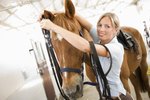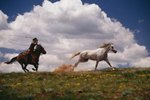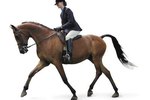
Your legs are the most powerful natural aids in any equestrian discipline. They work in conjunction with your seat and hands to control a horse, and they help you maintain balance in the saddle. Leg movements or aids can be either subtle or harsh, but precision is the most important factor. If you give the incorrect cue or give a unintentional command, the horse becomes confused and may misbehave out of frustration. In some equestrian sports, judges penalize riders for unnecessarily harsh leg movements, so train your horse to recognize and obey the inconspicuous cues.
Pressure
Leg movements control a horse through varying degrees of pressure. Increasing pressure encourages the horse to move in a specific direction or to engage a specific leg. For example, add pressure with the outside leg behind the girth to stimulate his outside hind leg, as well as pressure with the inside leg at the girth to ask for the canter or lope. Once your horse transitions into the desired gait, relieve the pressure. The relief tells your horse he has satisfied your request. Always give cues and aids with the least amount of pressure necessary to achieve the desired result. If your horse does not respond, continue increasing pressure until he does, then immediately release.
Calves
Your calves maintain near-constant contact with your horse's sides, which makes them powerful aids. Use them primarily to control a horse's hindquarters. Squeezing with your calves encourages your horse to move either forward or sideways, depending on the precise cue. They also create a wall when you want your horse to travel in a straight line or to turn in the opposite direction. For example, when trotting a circle to the left, your right calf maintains mild pressure against the horse's side to keep him tracking left.
Thighs
Your thighs work in concert with your hands to control the horse's front end. Closing your thighs against the saddle will close off the horse's shoulders and help you maintain controlled forward motion. Opening the thighs and knees allows the horse to lift his back and flex at the poll, which permits maximum impulsion from the hindquarters. If your horse picks up too much speed at the trot, for example, close your thighs and slow your posts to bring him back under control.
Position
Correct leg position varies slightly among different equestrian disciplines, but the relationships between different parts of the leg remain similar. An ideal leg position creates a straight line between the rider's ear, shoulder and heel. Lengthen your calf so your heel sinks below the ball of your foot, which helps you maintain balance in the saddle. Leg movements beyond this base position should be fast and accurate. For example, if you move one calf behind the girth to cue the horse, your leg should return immediately to its previous position.
Combinations
It takes time and practice to learn how to orchestrate leg movements so they complement one another. Leg movements can be combined with other natural and artificial aids, as well as with each other. The lower leg is responsible for creating forward momentum and impulsion, while the upper leg assists the hands and seat in maintaining control. It is important to give your cues in the same places every time. If you shorten or lengthen your stirrups, for example, you must adjust your cues and aids so you do not confuse the horse. Never allow your legs to bang against the horse's sides or to swing back and forth, as these inadvertent leg movements dilute your training and impair communication.
References
Photo Credits
-
Jupiterimages/Photos.com/Getty Images
Writer Bio
Laura College is a former riding instructor, horse trainer and veterinary assistant. She has worked as a writer since 2004, producing articles and sales copy for corporations and nonprofits. College has also published articles in numerous publications, including "On the Bit," "Practical Horseman" and "American Quarter Horse Journal."




